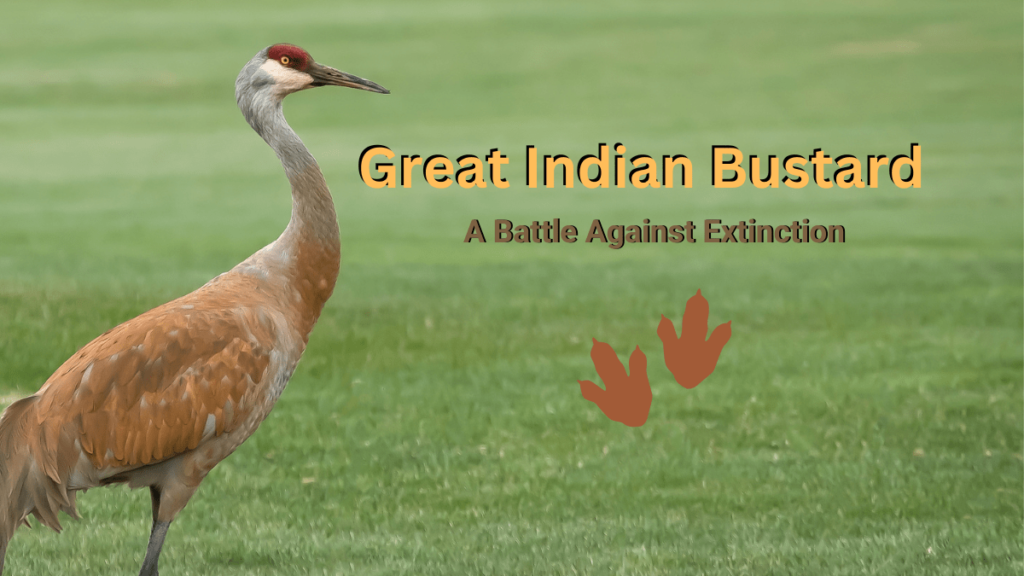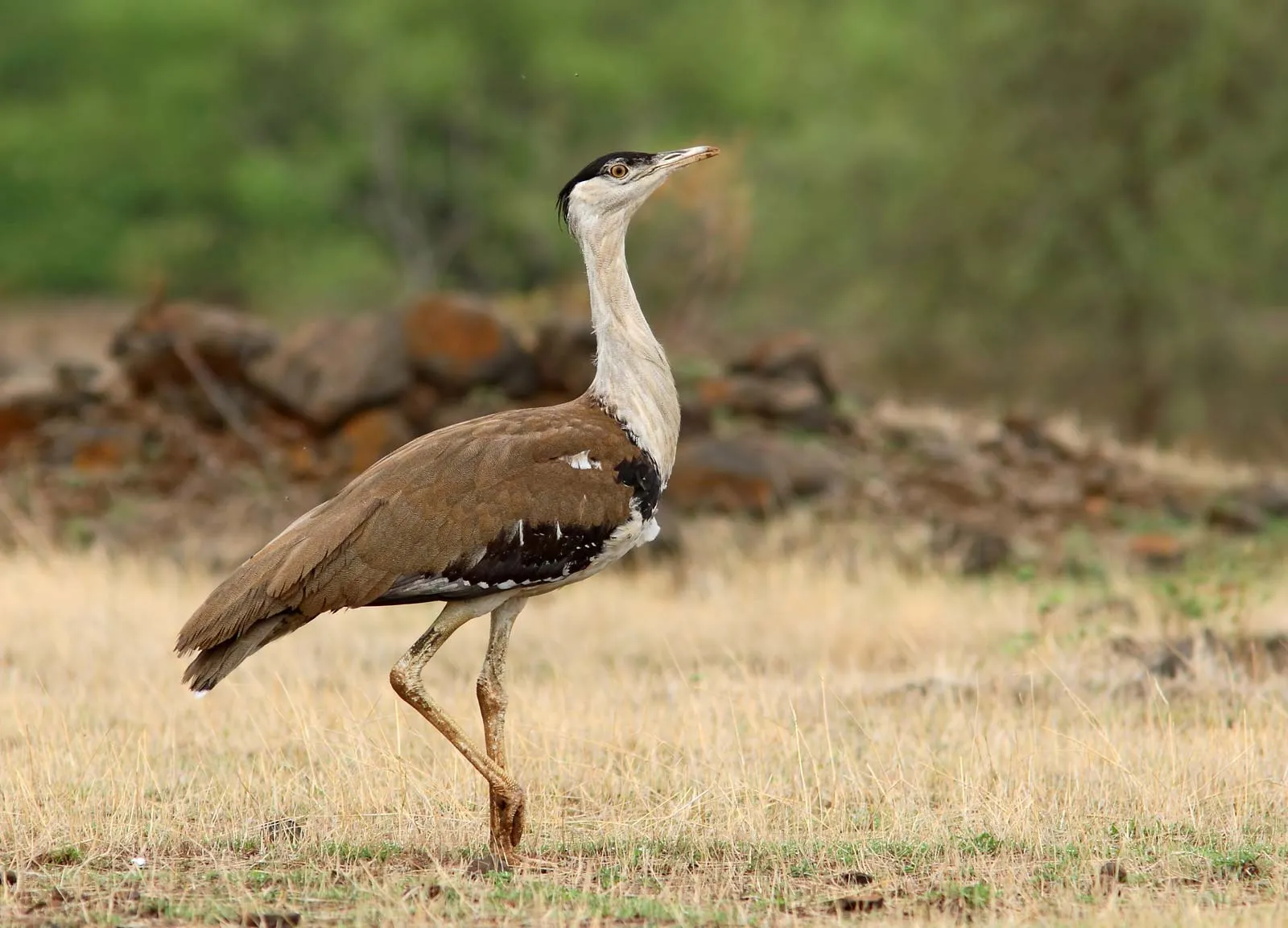The Great Indian Bustard is not just any bird, It is a symbol of India’s rapidly disappearing grassland ecosystems. It struggle that endangered species face in the modern world. With its towering height, unique plumage, and elusive behavior, this magnificent bird has garnered attention from conservationists, wildlife enthusiasts, and governments alike. However, despite numerous conservation efforts, the Great Indian Bustard is teetering on the brink of extinction, making it one of the most critically endangered bird species on the planet.
Overview of the Great Indian Bustard
The Great Indian Bustard (Ardeotis nigriceps) is one of the heaviest flying birds in the world, native to the Indian subcontinent. Standing tall at nearly 4 feet, this majestic grassland bird is known for its long legs, broad wings, and distinctive black crown on its head. These birds are adapted to live in dry, arid regions, particularly the desert ecosystems of Rajasthan, Gujarat, and parts of Maharashtra. Unfortunately, due to unchecked habitat destruction, human encroachment, and other factors, the Great Indian Bustard population has plummeted to dangerously low levels.
The Decline of a Species
Once common across the Indian grasslands, the population of Great Indian Bustards has declined by over 90% in the past few decades. The primary reason for this alarming decline is the loss of habitat. These birds thrive in open, arid regions like Indian grasslands and semi-deserts. However, due to urbanization, agricultural expansion, and infrastructure development, their natural habitat has been heavily degraded.
Habitat destruction isn’t the only issue. The Great Indian Bustard also faces threats from poaching, collision with power lines, and the illegal wildlife trade. Despite being legally protected under the Wildlife Protection Act of India, enforcement has been weak, and the bird continues to suffer.
Conservation Efforts: Fighting Extinction

- Breeding programs: Captive breeding and reintroduction efforts have been initiated to increase the bird’s population in the wild.
- Habitat restoration: Steps are being taken to restore the degraded grassland ecosystems. Habitat preservation is critical for the survival of these birds as they rely on large, undisturbed tracts of land to breed and forage.
- Wildlife sanctuaries: Protected areas like the Desert National Park in Rajasthan have been established to safeguard the bird’s remaining populations. These sanctuaries offer a safe haven for endangered wildlife, including the Great Indian Bustard.
- Poaching prevention: Tackling illegal wildlife trade and preventing poaching is another crucial aspect of conserving this species. Awareness programs and stricter enforcement of wildlife laws have been introduced to curb these illegal activities.
Despite these efforts, the Great Indian Bustard remains critically endangered. According to the International Union for Conservation of Nature (IUCN), there are only about 150 individuals left in the wild. This staggering number underlines the urgent need for action.
Challenges in Conservation
Saving the Great Indian Bustard is not an easy task. Human-wildlife conflict is a significant challenge, as the birds often inhabit areas close to human settlements and agricultural lands. The rapid expansion of infrastructure, particularly power lines and wind turbines, poses a severe threat. Many birds have died due to collisions with power lines that crisscross their habitat.
Moreover, the lack of public awareness about the biodiversity value of Indian ecosystems adds to the problem. Many locals view the Great Indian Bustard as a nuisance, and their presence in agricultural areas is seen as a threat to crops. Educating the public and involving local communities in wildlife conservation is critical to ensuring the survival of these birds.
The Importance of the Great Indian Bustard in Indian Ecosystems
The Great Indian Bustard is a keystone species in the Indian grasslands. It plays an essential role in maintaining the balance of the ecosystem by controlling insect populations and aiding in seed dispersal. The decline of such a species has a domino effect on the biodiversity of the region. Losing this bird would mean losing a vital part of India’s ecological balance.
Global Importance and Conservation Success Stories of Great Indian Bustard
The plight of the Great Indian Bustard is not just a national concern but a global one. The bird has been recognized as a priority species in international wildlife conservation efforts. Countries across the world have shown interest in supporting India’s efforts to save this species.
In some regions, like Mongolia and Africa, closely related species of bustards have seen successful recovery due to collaborative conservation efforts. These examples show that with concerted effort. The Great Indian Bustard can also be brought back from the brink of extinction.
Government and Policy Initiatives for Great Indian Bustard
The Indian government has initiated various policy-level actions to protect the Great Indian Bustard. In 2019, the Bustard Recovery Programme was launched. It focuses on critical actions like habitat preservation, reducing mortality due to power lines, and engaging local communities in wildlife protection.
Another significant step is the installation of bird diverters on power lines in key habitats to prevent avian fatalities. These diverters help make the power lines visible to birds, thus reducing the risk of collision.
Moreover, the government has been working with NGOs and international conservation organizations to create and implement effective strategies for species conservation.
The Role of Public Awareness and Eco-Tourism
Public awareness and eco-tourism can play a significant role in wildlife conservation. As more people become aware of the endangered species around them. There is a higher chance of building public support for conservation efforts. Promoting birdwatching and sustainable tourism in regions where the Great Indian Bustard is found can generate revenue, which can then be reinvested into wildlife protection.
Many wildlife sanctuaries across India have started offering guided tours focused on birdwatching. It allows visitors to see the Great Indian Bustard in its natural habitat while learning about the importance of biodiversity.
The survival of the Great Indian Bustard is a matter of urgent concern, not just for India but for the entire world. As one of the most critically endangered birds globally. Its future depends on collective efforts from governments, NGOs, and local communities. The ongoing conservation efforts, from habitat restoration to poaching prevention, offer a glimmer of hope. However, much more needs to be done to ensure that future generations can witness the Great Indian Bustard in the wild, rather than reading about it as a species lost to extinction.
Also know about Endangered Animal Species in India
Discover more from Bhuchi's World
Subscribe to get the latest posts sent to your email.

